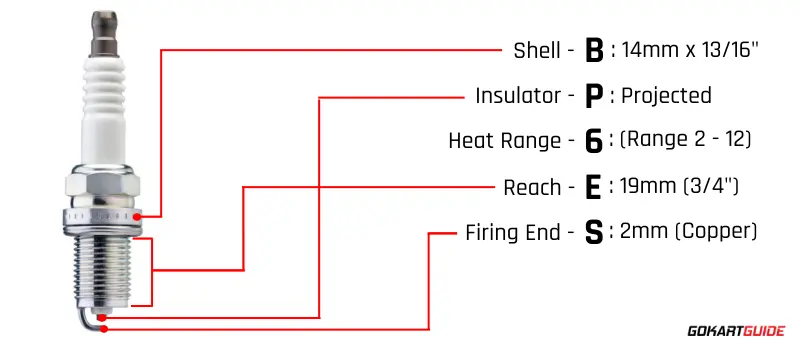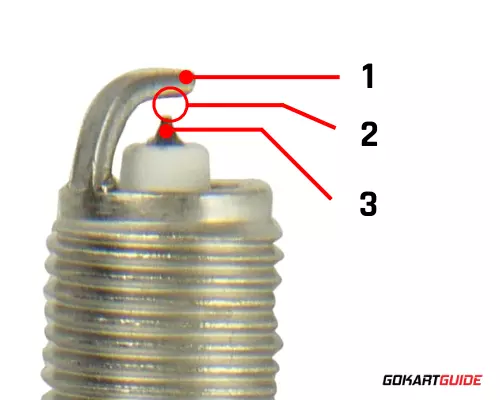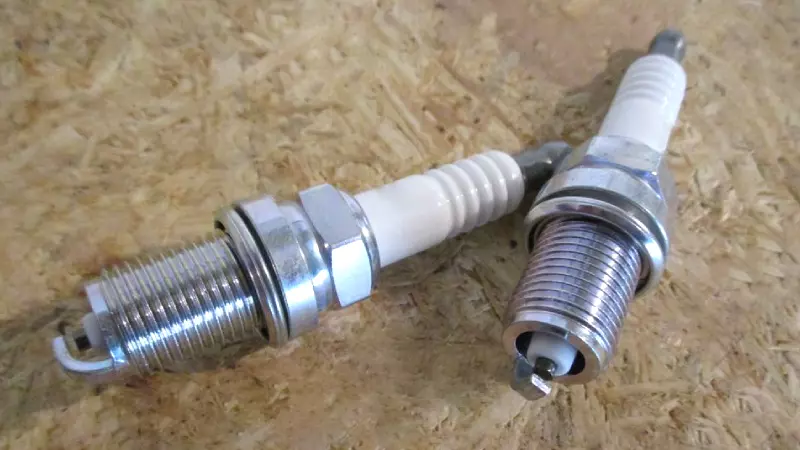A spark plug produces a spark at a specific time to ignite the air-fuel mixture inside the Predator’s combustion chamber. This spark allows the fuel and air inside the engine to combust, in turn producing mechanical energy.
In this article, I’ll be showing you the correct spark plug type, the best spark plugs, the correct spark plug gap and a guide on how to change the spark plug of a Predator 212 engine.
Spark Plug Type
Predator 212 engines are compatible with a specific type of spark plug that are referenced as NGK BP6ES and NHSP/Torch F6TC. Both of these spark plugs share the same specifications and properties. Below, you’ll see an explanation on how to read it.

As you can see from the illustration above, the spark plug type BP6ES stands for the corresponding terms and values:
- B = Shell (14 mm x 13/16”)
- P = Insulator (Projected)
- 6 = Heat Range (2 – 12)
- E = Reach 19 mm (3/4″)
- S = Firing End 2mm (Copper Core)
You’ll need to make sure that any replacement spark plug matches the shell dimensions, has a projected insulator, supports a heat range of 6, has a reach of 19 mm and has a 2 mm firing end made of a copper core.
Best Spark Plugs for Predator 212 Engines
There are various spark plug manufacturers on the market that offer a wide variety of spark plugs for the Predator 212. However, I strongly suggest sticking to the Predator’s recommended specifications. The one below is what I use for my Predator 212 engine.
The spark plug that Predator recommends in the owner’s manual, is the NGK BP6ES. They can be quite hard to find, as you’ll need to ensure that the gap is within the recommended range. Therefore, I recommend the Autolite AR3910X Racing Spark Plug. It’s a high-performance spark plug that can even boost the overall engine output.
If you’re looking for a non-racing version, the E3.22 Spark Plug is also a good choice. Both of these spark plugs are fully compatible with the Predator 212 engine and tick all the boxes in terms of shell size, insulator type, heat range, reach and firing end material.
Spark Plug Gap
The recommended Predator 212 spark plug gap is 0.027” – 0.031”. The spark plug gap (also known as electrode gap) is the physical distance between the ground electrode and the center electrode. To further understand what a spark plug gap is, use the illustration below.

Spark Plug Gap Description
- Ground Electrode
- Spark Plug Gap (Electrode Gap)
- Center Electrode
It’s important to use a spark plug that has a gap between 0.027” – 0.031” for your Predator engine. If you’re replacing your spark plug make sure that the electrode gap is within the above range. Although a slightly smaller or larger gap may still cause your engine to run, it’s best to stick to the recommendations, due to the following reasons.
The reason why a spark plug needs to have a compatible gap is because the arc of the spark plug occurs in between the center electrode and the ground electrode. If the gap is too small, the spark would most likely be too weak for the Predator 212 engine and can cause poor performance.
Conversely, if the spark plug gap is too large, the spark may be too strong and eventually cause your Predator 212 engine to overheat.
Spark Plug Changing Guide
In this section, I’ll teach you how to replace the spark plug on a Predator 212 engine. Take note that you will need a suitable socket to remove the spark plug.
- Locate the spark plug, which is found just above the valve cover, which is marked (OHV) and underneath the air filter assembly.
- Remove the spark plug plug boot.
- Use a suitable socket to loosen the spark plug by turning it counterclockwise.
- Remove the spark plug and replace it with a new one.
- Use the same socket to tighten it by turning it clockwise this time.
- Reinstall the spark plug boot.
Before replacing your spark plug, always check the spark plug gap of the new spark plug and ensure that it falls within the recommended 0.027” – 0.031” gap. Moreover, ensure that the spark plug is tightly secured. A loose spark plug may overheat the engine and if tightened too much can spoil the thread.
Frequently Asked Questions
If you still have some questions about Predator 212 spark plugs, feel free to read through more information below. Here, I’ll answer some of the most frequently asked questions that were sent in.
How Many Spark Plugs Does A Predator 212 Need?
The Predator 212 engine requires only 1 spark plug. This is because this Predator engine has a single cylinder and each cylinder typically requires one spark plug, in order to ignite the air-fuel mixture.
How Often Should I Check the Spark Plug?
According to the Predator 212 owner’s manual, you should inspect and clean the spark plug every 6 months or 100 hours of use (whichever is sooner). When required, replace your spark plug with a new one. This will allow you to protect your engine from damage and also get more performance out of it.
Do I Need to Check the Spark Plug Gap?
You’re encouraged to check the spark plug gap, also referred to as electrode gap, upon installing a new spark plug. Even though spark plug manufacturers try to ensure that the electrode gap is as indicated, there may be a margin of error.
Therefore, it’s always best to ensure that the gap between the center electrode and the ground electrode are within the 0.027” – 0.031” range, as recommended for the Predator 212 engine.
Does My Predator 212 Engine Need a Spark Plug?
Yes, your engine needs a spark plug and without one, it wouldn’t start. All combustion engines, such as the Predator 212, need fuel, air and an ignition to start and maintain the combustion cycle within the cylinder. Without a spark plug, your engine would not be able to ignite the air-fuel mixture.


